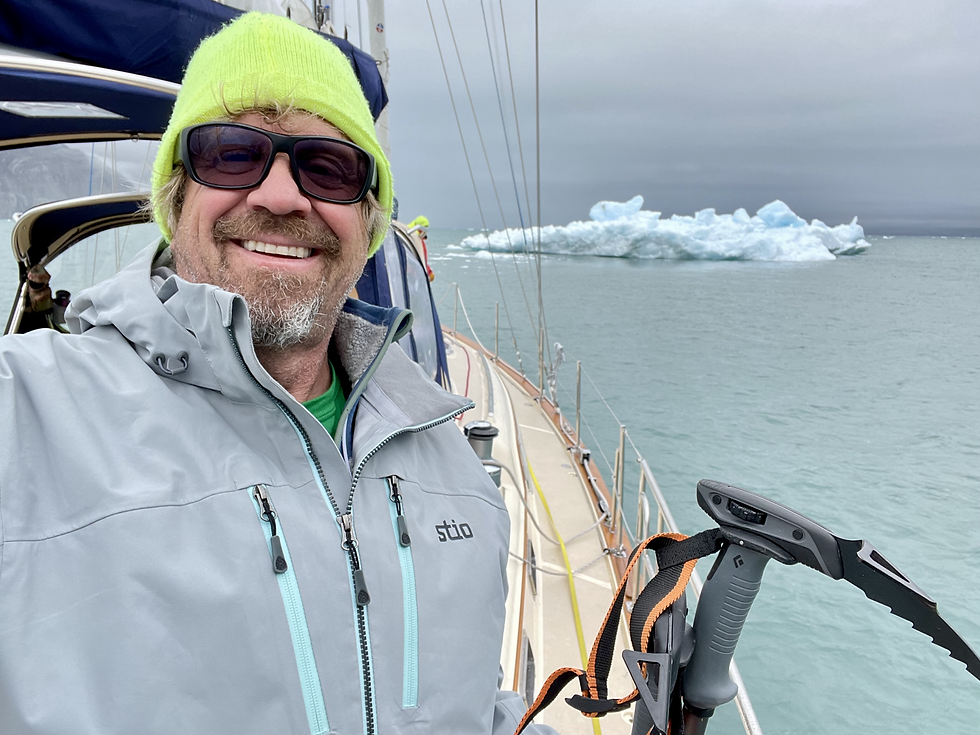Day 62 – Mile 5735 – Leaving Columbia Arm, Alaska
- svkailani
- Aug 19, 2021
- 3 min read
If there could have been a better way to finish this amazing expedition anadventure, I don’t know what it would be. Today we took the boat into a moving icefield to get as close as we could to the fastest moving glacier in the world, the Columbia Glacier. In a way, we viewed this day as a test drive for the Northwest Passage trip in two years. Maybe even an opportunity to test our bamboo and stainless home made 14’ ice poles.

We started from Emerald Bay and were immediately greeted by a few icebergs in the fjord. The fjord is basically Yosemite Valley except with water 1000' deep. All of Prince William Sound (and Kodiak as well) are glacial and therefore very deep, flat bottomed fjords with very steep sides. The Columbia Arm runs 8 or so miles, but about 5 miles in there is a sudden 50 foot deep sandbar interrupting what is otherwise a 1000' deep fjord. The bar runs completely across the fjord, left there in the last cycle of ice and the furthest point of travel of the glacier system. A giant iceberg is stuck on the bar, about 20' high above the water and probably another 80+ below, grounded on the terminus rocks. Today the bar is miles away from the current terminus of the glacier, and getting farther every day as we will soon see.


We start to see increasing sea ice and parts of the glacier come in to view. We realize that the entire multi-mile wall is all actually glacier. Most of it covered in dirt and rocks, but parts that move faster showing the usual white and blue. The ice flow begins to get thicker. We can still navigate freely, and I spot a channel that goes up towards the active eastern end of the glacial wall. Fasicnatingly, we are actually well within the glacier according to the chart. The glacier, like most, is retreating, and quite rapidly in this case. We are already probably 1/2 mile in with a good bit to go.

We pick our way through icebergs big and small, and Josh and Brian start fending off with the poles. It’s good to be able to test them out. We thread our way along, silently and slowly, taking in the surreal landscape. Seals float on random icebergs all around us. Huge groans are constantly issuing from the glacier. We stop and listen to the ice snapping as bubbles in the ice pop, the groaning of the glacier, and occasionally incredible rumbles as Ice calves. glacier. By now the wall is less than 1/2 mile away, and we hear another loud crash as a large piece of ice falls somewhere, and the thought of a larger wave coming through a crowded ice field comes to mind...




And suddenly, with that thought, we have gotten to a point where we aren’t comfortable going too much further and the wind is starting to pick up as well - from 3 to 6 knots out from the glacier. Seems like not much but it doesn't take much to spread the ice. The danger is that the change and increase in wind moves the floe and blocks our way out for a while, or at least makes the journey much more difficult. We turn tail and work our way through an ice field that is much more crowded and dispersed due to the wind. It’s a clear reminder of the dynamic and dangerous nature of the ice floe. We pick and fend our way through, getting up close to a few larger bergs. I see one that has a shear wall and we nose right up to it. Josh and Kevin push off and Brian captures the moment on video. We continue to thread our way along and finally exit the floe into open water.



As we leave the arm, we pause for some drone footage next to another iceberg and consider getting on it until a wave coming from the glacier a mile away causes the berg to rock and calve off a big chunk. Quick reminder not to do stupid shit.





We back away and begin the 40+ mile trip to Valdez…and the end of journey #1.




Comments